Evaluating Hazardous Waste Management Strategies in Shanghai
VerifiedAdded on 2023/06/07
|10
|2854
|137
Report
AI Summary
This report provides an overview of hazardous waste management in Shanghai, China, addressing the generation of hazardous waste, the existing management system, prediction of future waste quantities, and major problems and issues. It highlights the impact of industrialization on waste production, including industrial, medical, and domestic wastes, and examines methods like incineration, rural landfills, recycling, and scavengers. The report also discusses the environmental consequences of inadequate waste management, such as deforestation, pollution, and biodiversity loss, emphasizing the need for improved strategies and policies to mitigate these challenges and protect public health and the environment. It concludes that Shanghai, as a developed region with a large population, faces significant challenges in managing its hazardous waste, requiring urgent attention and effective waste management operations.
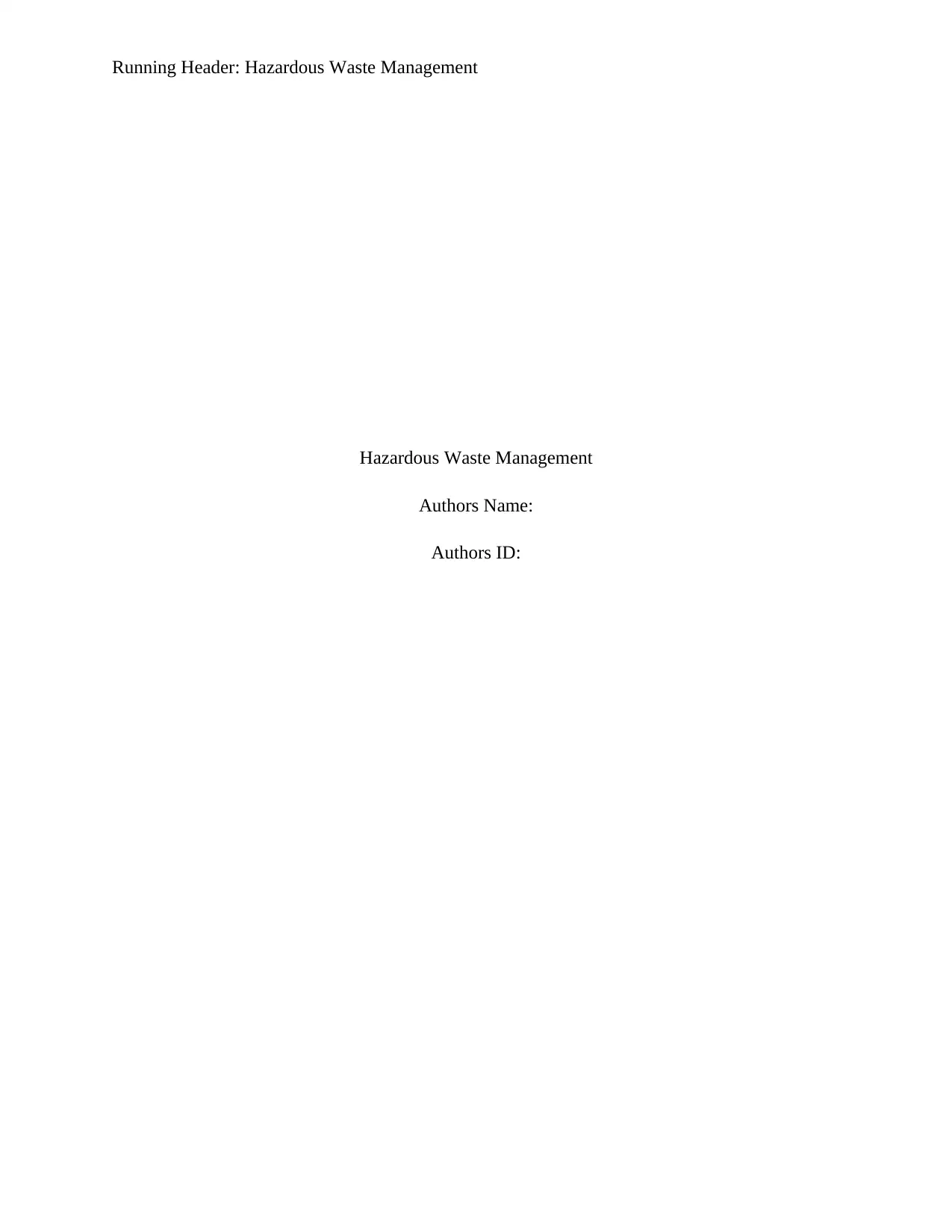
Running Header: Hazardous Waste Management
Hazardous Waste Management
Authors Name:
Authors ID:
Hazardous Waste Management
Authors Name:
Authors ID:
Paraphrase This Document
Need a fresh take? Get an instant paraphrase of this document with our AI Paraphraser
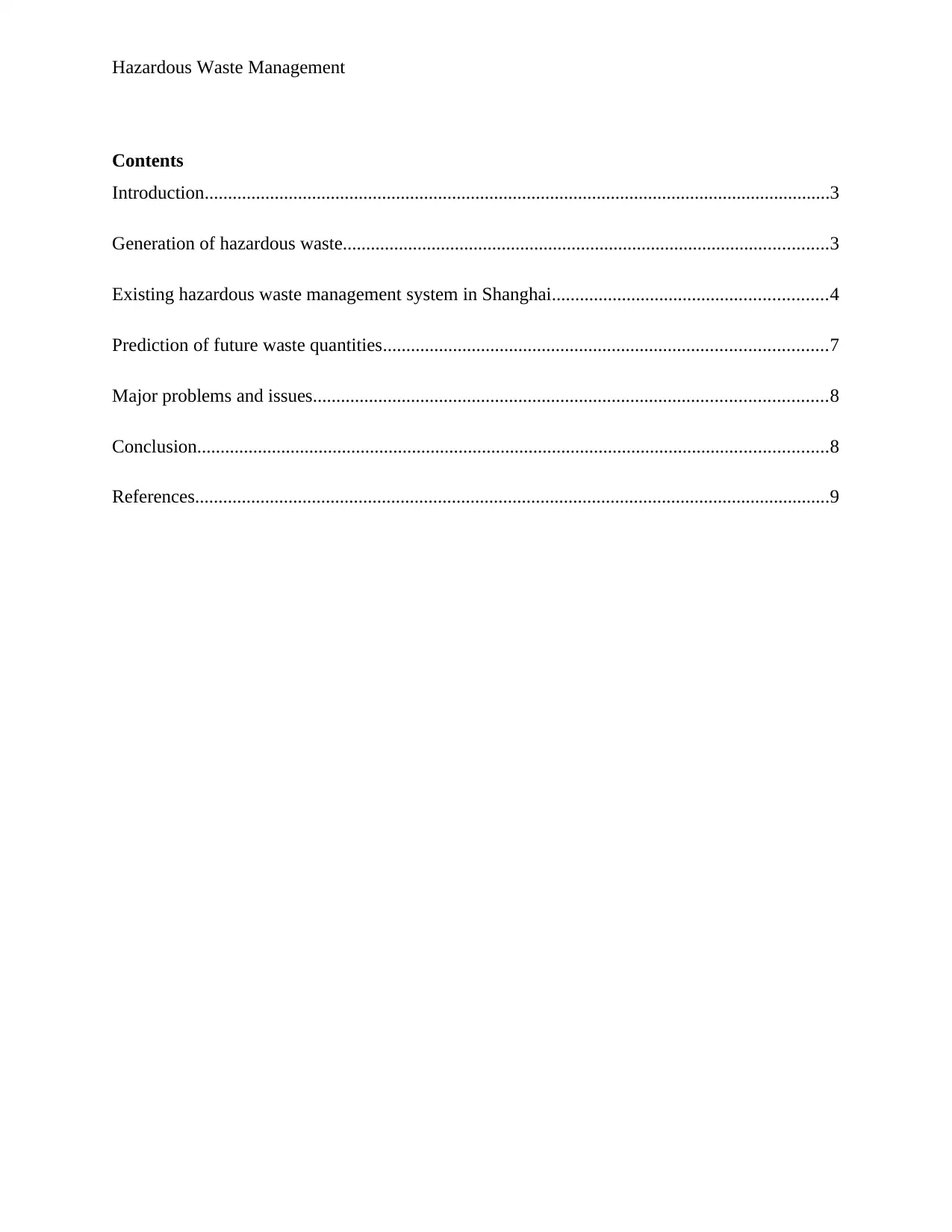
Hazardous Waste Management
Contents
Introduction......................................................................................................................................3
Generation of hazardous waste........................................................................................................3
Existing hazardous waste management system in Shanghai...........................................................4
Prediction of future waste quantities...............................................................................................7
Major problems and issues..............................................................................................................8
Conclusion.......................................................................................................................................8
References........................................................................................................................................9
Contents
Introduction......................................................................................................................................3
Generation of hazardous waste........................................................................................................3
Existing hazardous waste management system in Shanghai...........................................................4
Prediction of future waste quantities...............................................................................................7
Major problems and issues..............................................................................................................8
Conclusion.......................................................................................................................................8
References........................................................................................................................................9
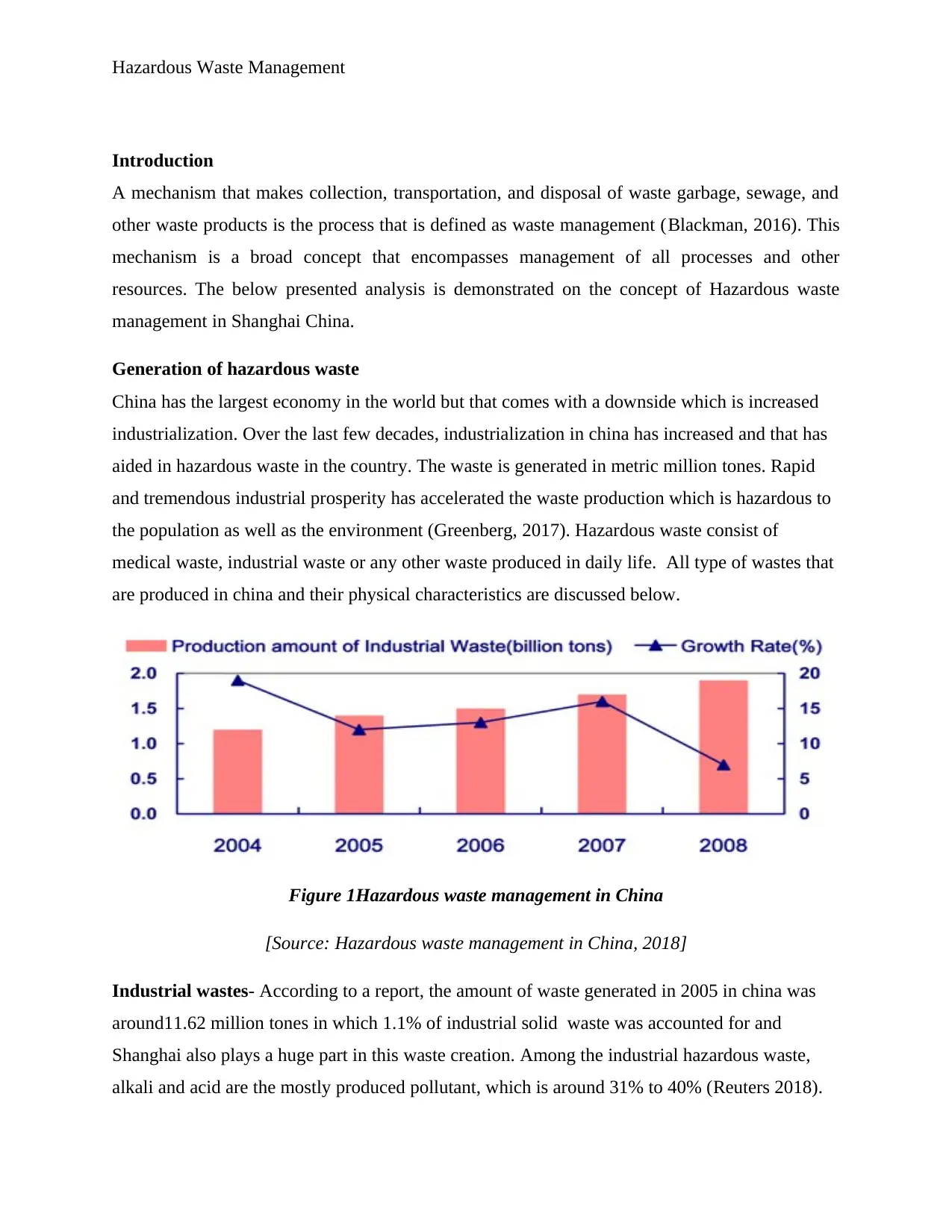
Hazardous Waste Management
Introduction
A mechanism that makes collection, transportation, and disposal of waste garbage, sewage, and
other waste products is the process that is defined as waste management (Blackman, 2016). This
mechanism is a broad concept that encompasses management of all processes and other
resources. The below presented analysis is demonstrated on the concept of Hazardous waste
management in Shanghai China.
Generation of hazardous waste
China has the largest economy in the world but that comes with a downside which is increased
industrialization. Over the last few decades, industrialization in china has increased and that has
aided in hazardous waste in the country. The waste is generated in metric million tones. Rapid
and tremendous industrial prosperity has accelerated the waste production which is hazardous to
the population as well as the environment (Greenberg, 2017). Hazardous waste consist of
medical waste, industrial waste or any other waste produced in daily life. All type of wastes that
are produced in china and their physical characteristics are discussed below.
Figure 1Hazardous waste management in China
[Source: Hazardous waste management in China, 2018]
Industrial wastes- According to a report, the amount of waste generated in 2005 in china was
around11.62 million tones in which 1.1% of industrial solid waste was accounted for and
Shanghai also plays a huge part in this waste creation. Among the industrial hazardous waste,
alkali and acid are the mostly produced pollutant, which is around 31% to 40% (Reuters 2018).
Introduction
A mechanism that makes collection, transportation, and disposal of waste garbage, sewage, and
other waste products is the process that is defined as waste management (Blackman, 2016). This
mechanism is a broad concept that encompasses management of all processes and other
resources. The below presented analysis is demonstrated on the concept of Hazardous waste
management in Shanghai China.
Generation of hazardous waste
China has the largest economy in the world but that comes with a downside which is increased
industrialization. Over the last few decades, industrialization in china has increased and that has
aided in hazardous waste in the country. The waste is generated in metric million tones. Rapid
and tremendous industrial prosperity has accelerated the waste production which is hazardous to
the population as well as the environment (Greenberg, 2017). Hazardous waste consist of
medical waste, industrial waste or any other waste produced in daily life. All type of wastes that
are produced in china and their physical characteristics are discussed below.
Figure 1Hazardous waste management in China
[Source: Hazardous waste management in China, 2018]
Industrial wastes- According to a report, the amount of waste generated in 2005 in china was
around11.62 million tones in which 1.1% of industrial solid waste was accounted for and
Shanghai also plays a huge part in this waste creation. Among the industrial hazardous waste,
alkali and acid are the mostly produced pollutant, which is around 31% to 40% (Reuters 2018).
⊘ This is a preview!⊘
Do you want full access?
Subscribe today to unlock all pages.

Trusted by 1+ million students worldwide
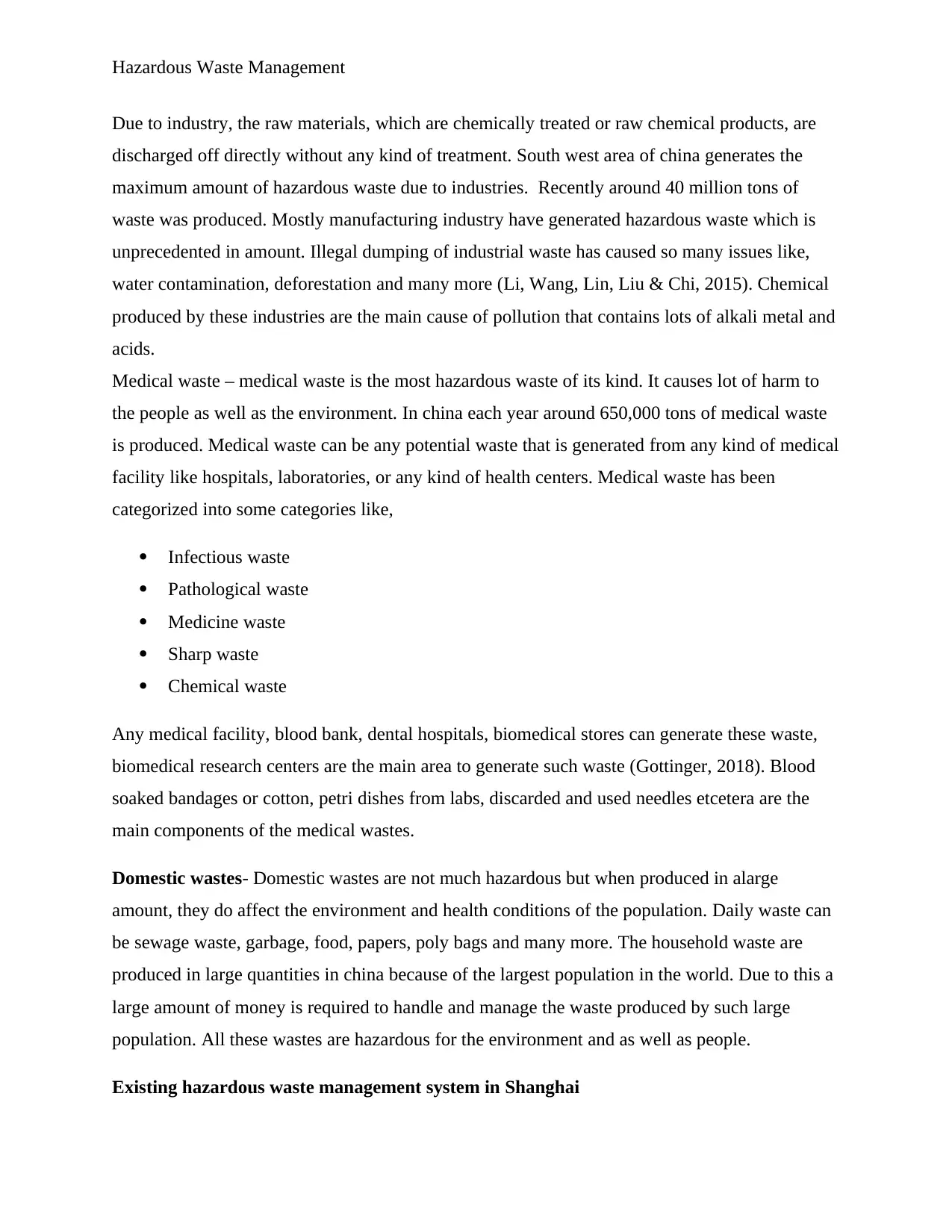
Hazardous Waste Management
Due to industry, the raw materials, which are chemically treated or raw chemical products, are
discharged off directly without any kind of treatment. South west area of china generates the
maximum amount of hazardous waste due to industries. Recently around 40 million tons of
waste was produced. Mostly manufacturing industry have generated hazardous waste which is
unprecedented in amount. Illegal dumping of industrial waste has caused so many issues like,
water contamination, deforestation and many more (Li, Wang, Lin, Liu & Chi, 2015). Chemical
produced by these industries are the main cause of pollution that contains lots of alkali metal and
acids.
Medical waste – medical waste is the most hazardous waste of its kind. It causes lot of harm to
the people as well as the environment. In china each year around 650,000 tons of medical waste
is produced. Medical waste can be any potential waste that is generated from any kind of medical
facility like hospitals, laboratories, or any kind of health centers. Medical waste has been
categorized into some categories like,
Infectious waste
Pathological waste
Medicine waste
Sharp waste
Chemical waste
Any medical facility, blood bank, dental hospitals, biomedical stores can generate these waste,
biomedical research centers are the main area to generate such waste (Gottinger, 2018). Blood
soaked bandages or cotton, petri dishes from labs, discarded and used needles etcetera are the
main components of the medical wastes.
Domestic wastes- Domestic wastes are not much hazardous but when produced in alarge
amount, they do affect the environment and health conditions of the population. Daily waste can
be sewage waste, garbage, food, papers, poly bags and many more. The household waste are
produced in large quantities in china because of the largest population in the world. Due to this a
large amount of money is required to handle and manage the waste produced by such large
population. All these wastes are hazardous for the environment and as well as people.
Existing hazardous waste management system in Shanghai
Due to industry, the raw materials, which are chemically treated or raw chemical products, are
discharged off directly without any kind of treatment. South west area of china generates the
maximum amount of hazardous waste due to industries. Recently around 40 million tons of
waste was produced. Mostly manufacturing industry have generated hazardous waste which is
unprecedented in amount. Illegal dumping of industrial waste has caused so many issues like,
water contamination, deforestation and many more (Li, Wang, Lin, Liu & Chi, 2015). Chemical
produced by these industries are the main cause of pollution that contains lots of alkali metal and
acids.
Medical waste – medical waste is the most hazardous waste of its kind. It causes lot of harm to
the people as well as the environment. In china each year around 650,000 tons of medical waste
is produced. Medical waste can be any potential waste that is generated from any kind of medical
facility like hospitals, laboratories, or any kind of health centers. Medical waste has been
categorized into some categories like,
Infectious waste
Pathological waste
Medicine waste
Sharp waste
Chemical waste
Any medical facility, blood bank, dental hospitals, biomedical stores can generate these waste,
biomedical research centers are the main area to generate such waste (Gottinger, 2018). Blood
soaked bandages or cotton, petri dishes from labs, discarded and used needles etcetera are the
main components of the medical wastes.
Domestic wastes- Domestic wastes are not much hazardous but when produced in alarge
amount, they do affect the environment and health conditions of the population. Daily waste can
be sewage waste, garbage, food, papers, poly bags and many more. The household waste are
produced in large quantities in china because of the largest population in the world. Due to this a
large amount of money is required to handle and manage the waste produced by such large
population. All these wastes are hazardous for the environment and as well as people.
Existing hazardous waste management system in Shanghai
Paraphrase This Document
Need a fresh take? Get an instant paraphrase of this document with our AI Paraphraser
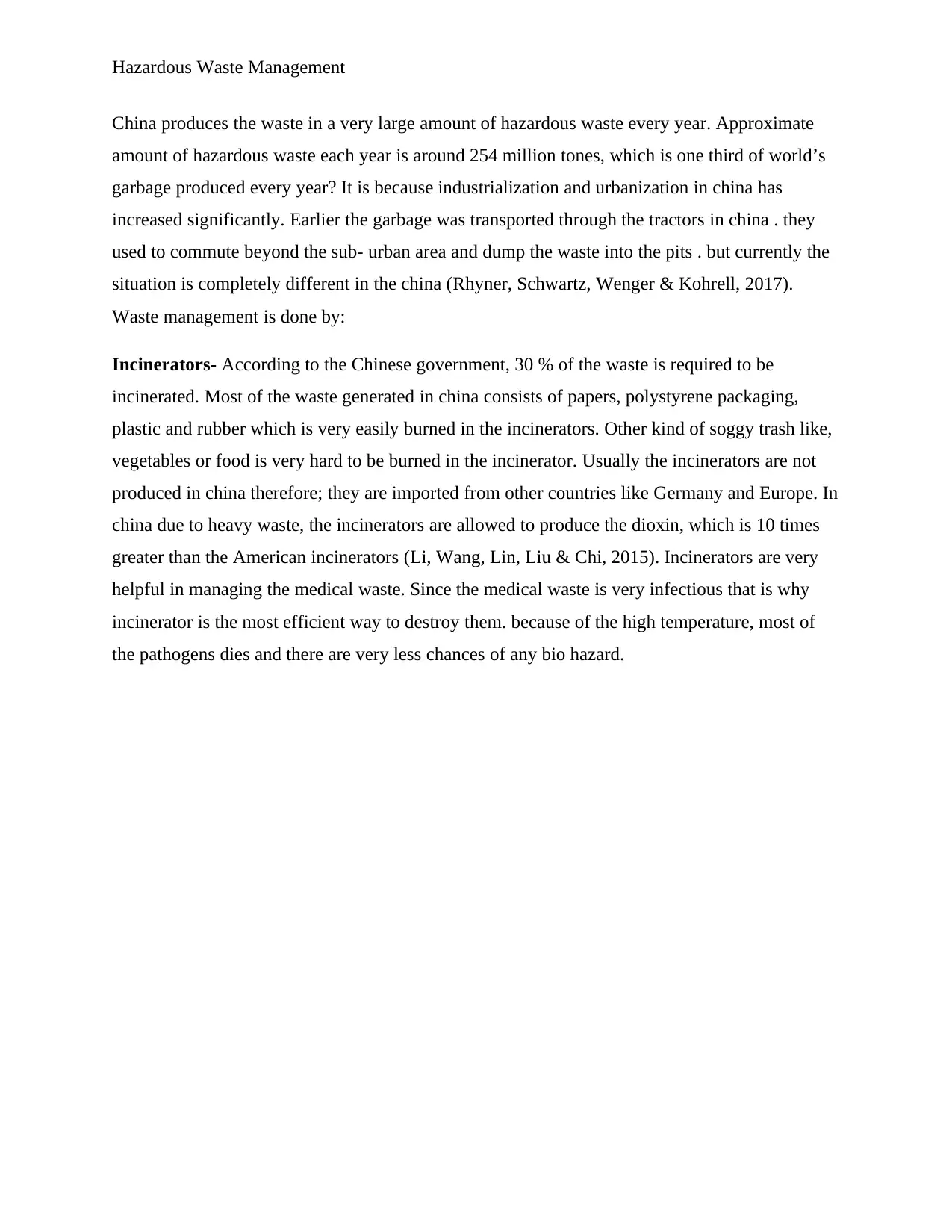
Hazardous Waste Management
China produces the waste in a very large amount of hazardous waste every year. Approximate
amount of hazardous waste each year is around 254 million tones, which is one third of world’s
garbage produced every year? It is because industrialization and urbanization in china has
increased significantly. Earlier the garbage was transported through the tractors in china . they
used to commute beyond the sub- urban area and dump the waste into the pits . but currently the
situation is completely different in the china (Rhyner, Schwartz, Wenger & Kohrell, 2017).
Waste management is done by:
Incinerators- According to the Chinese government, 30 % of the waste is required to be
incinerated. Most of the waste generated in china consists of papers, polystyrene packaging,
plastic and rubber which is very easily burned in the incinerators. Other kind of soggy trash like,
vegetables or food is very hard to be burned in the incinerator. Usually the incinerators are not
produced in china therefore; they are imported from other countries like Germany and Europe. In
china due to heavy waste, the incinerators are allowed to produce the dioxin, which is 10 times
greater than the American incinerators (Li, Wang, Lin, Liu & Chi, 2015). Incinerators are very
helpful in managing the medical waste. Since the medical waste is very infectious that is why
incinerator is the most efficient way to destroy them. because of the high temperature, most of
the pathogens dies and there are very less chances of any bio hazard.
China produces the waste in a very large amount of hazardous waste every year. Approximate
amount of hazardous waste each year is around 254 million tones, which is one third of world’s
garbage produced every year? It is because industrialization and urbanization in china has
increased significantly. Earlier the garbage was transported through the tractors in china . they
used to commute beyond the sub- urban area and dump the waste into the pits . but currently the
situation is completely different in the china (Rhyner, Schwartz, Wenger & Kohrell, 2017).
Waste management is done by:
Incinerators- According to the Chinese government, 30 % of the waste is required to be
incinerated. Most of the waste generated in china consists of papers, polystyrene packaging,
plastic and rubber which is very easily burned in the incinerators. Other kind of soggy trash like,
vegetables or food is very hard to be burned in the incinerator. Usually the incinerators are not
produced in china therefore; they are imported from other countries like Germany and Europe. In
china due to heavy waste, the incinerators are allowed to produce the dioxin, which is 10 times
greater than the American incinerators (Li, Wang, Lin, Liu & Chi, 2015). Incinerators are very
helpful in managing the medical waste. Since the medical waste is very infectious that is why
incinerator is the most efficient way to destroy them. because of the high temperature, most of
the pathogens dies and there are very less chances of any bio hazard.
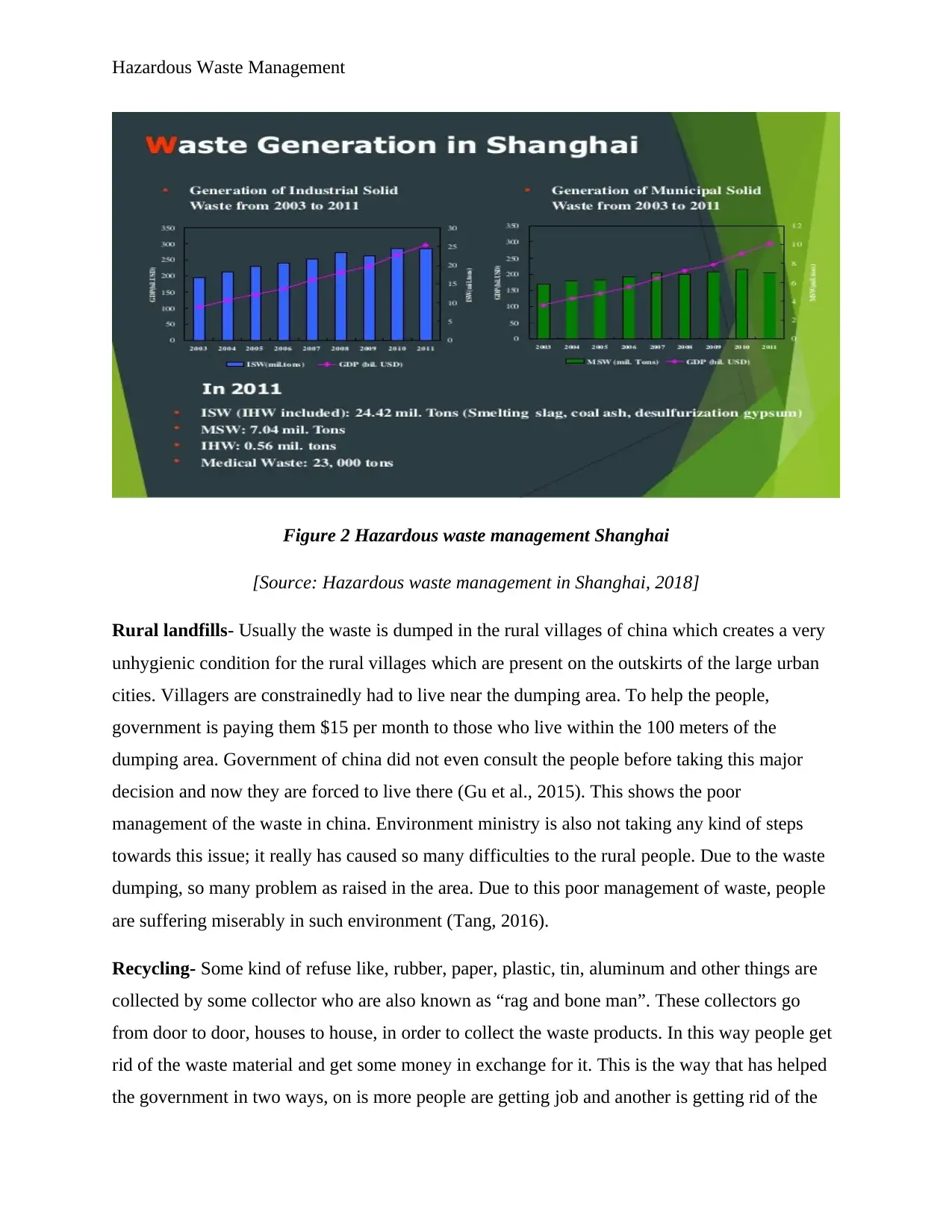
Hazardous Waste Management
Figure 2 Hazardous waste management Shanghai
[Source: Hazardous waste management in Shanghai, 2018]
Rural landfills- Usually the waste is dumped in the rural villages of china which creates a very
unhygienic condition for the rural villages which are present on the outskirts of the large urban
cities. Villagers are constrainedly had to live near the dumping area. To help the people,
government is paying them $15 per month to those who live within the 100 meters of the
dumping area. Government of china did not even consult the people before taking this major
decision and now they are forced to live there (Gu et al., 2015). This shows the poor
management of the waste in china. Environment ministry is also not taking any kind of steps
towards this issue; it really has caused so many difficulties to the rural people. Due to the waste
dumping, so many problem as raised in the area. Due to this poor management of waste, people
are suffering miserably in such environment (Tang, 2016).
Recycling- Some kind of refuse like, rubber, paper, plastic, tin, aluminum and other things are
collected by some collector who are also known as “rag and bone man”. These collectors go
from door to door, houses to house, in order to collect the waste products. In this way people get
rid of the waste material and get some money in exchange for it. This is the way that has helped
the government in two ways, on is more people are getting job and another is getting rid of the
Figure 2 Hazardous waste management Shanghai
[Source: Hazardous waste management in Shanghai, 2018]
Rural landfills- Usually the waste is dumped in the rural villages of china which creates a very
unhygienic condition for the rural villages which are present on the outskirts of the large urban
cities. Villagers are constrainedly had to live near the dumping area. To help the people,
government is paying them $15 per month to those who live within the 100 meters of the
dumping area. Government of china did not even consult the people before taking this major
decision and now they are forced to live there (Gu et al., 2015). This shows the poor
management of the waste in china. Environment ministry is also not taking any kind of steps
towards this issue; it really has caused so many difficulties to the rural people. Due to the waste
dumping, so many problem as raised in the area. Due to this poor management of waste, people
are suffering miserably in such environment (Tang, 2016).
Recycling- Some kind of refuse like, rubber, paper, plastic, tin, aluminum and other things are
collected by some collector who are also known as “rag and bone man”. These collectors go
from door to door, houses to house, in order to collect the waste products. In this way people get
rid of the waste material and get some money in exchange for it. This is the way that has helped
the government in two ways, on is more people are getting job and another is getting rid of the
⊘ This is a preview!⊘
Do you want full access?
Subscribe today to unlock all pages.

Trusted by 1+ million students worldwide
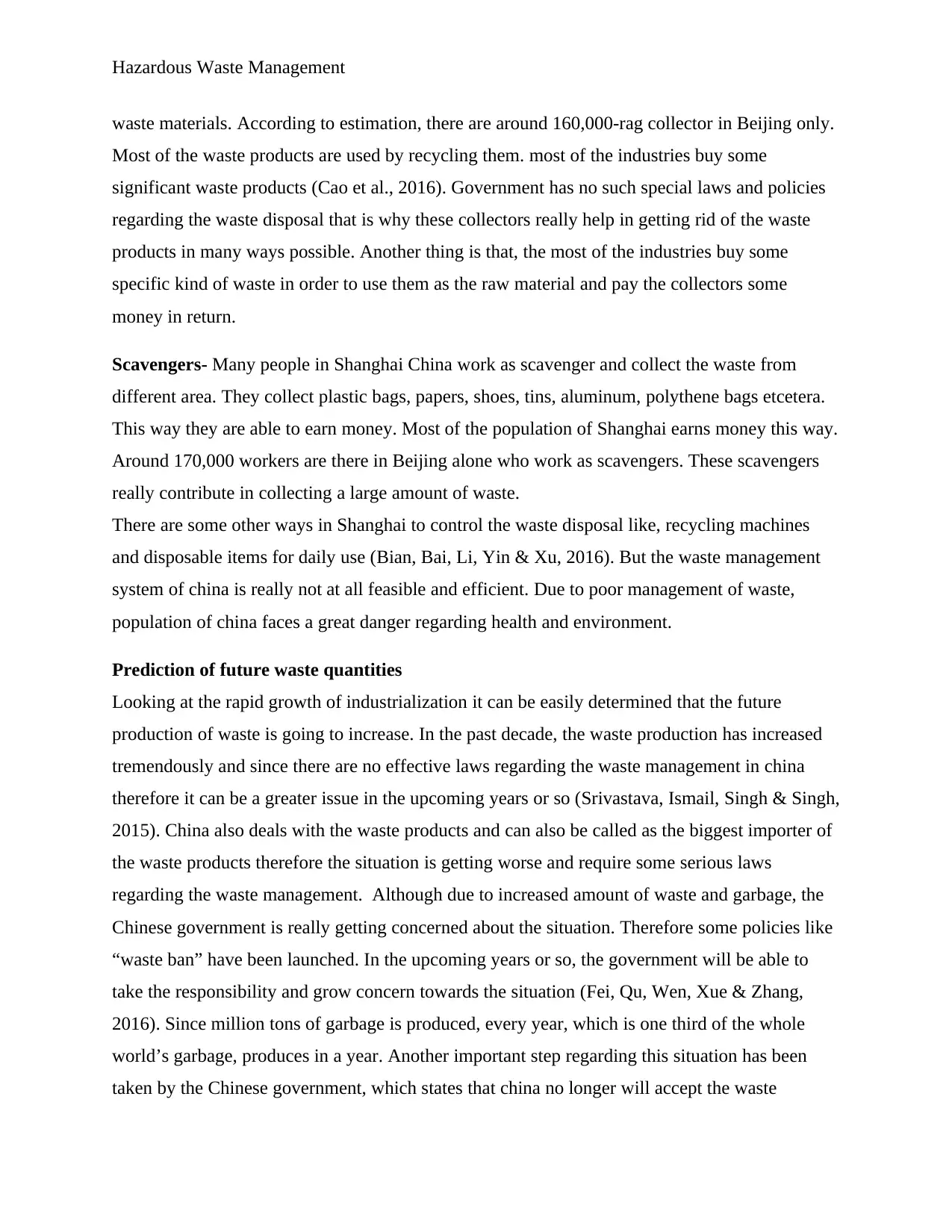
Hazardous Waste Management
waste materials. According to estimation, there are around 160,000-rag collector in Beijing only.
Most of the waste products are used by recycling them. most of the industries buy some
significant waste products (Cao et al., 2016). Government has no such special laws and policies
regarding the waste disposal that is why these collectors really help in getting rid of the waste
products in many ways possible. Another thing is that, the most of the industries buy some
specific kind of waste in order to use them as the raw material and pay the collectors some
money in return.
Scavengers- Many people in Shanghai China work as scavenger and collect the waste from
different area. They collect plastic bags, papers, shoes, tins, aluminum, polythene bags etcetera.
This way they are able to earn money. Most of the population of Shanghai earns money this way.
Around 170,000 workers are there in Beijing alone who work as scavengers. These scavengers
really contribute in collecting a large amount of waste.
There are some other ways in Shanghai to control the waste disposal like, recycling machines
and disposable items for daily use (Bian, Bai, Li, Yin & Xu, 2016). But the waste management
system of china is really not at all feasible and efficient. Due to poor management of waste,
population of china faces a great danger regarding health and environment.
Prediction of future waste quantities
Looking at the rapid growth of industrialization it can be easily determined that the future
production of waste is going to increase. In the past decade, the waste production has increased
tremendously and since there are no effective laws regarding the waste management in china
therefore it can be a greater issue in the upcoming years or so (Srivastava, Ismail, Singh & Singh,
2015). China also deals with the waste products and can also be called as the biggest importer of
the waste products therefore the situation is getting worse and require some serious laws
regarding the waste management. Although due to increased amount of waste and garbage, the
Chinese government is really getting concerned about the situation. Therefore some policies like
“waste ban” have been launched. In the upcoming years or so, the government will be able to
take the responsibility and grow concern towards the situation (Fei, Qu, Wen, Xue & Zhang,
2016). Since million tons of garbage is produced, every year, which is one third of the whole
world’s garbage, produces in a year. Another important step regarding this situation has been
taken by the Chinese government, which states that china no longer will accept the waste
waste materials. According to estimation, there are around 160,000-rag collector in Beijing only.
Most of the waste products are used by recycling them. most of the industries buy some
significant waste products (Cao et al., 2016). Government has no such special laws and policies
regarding the waste disposal that is why these collectors really help in getting rid of the waste
products in many ways possible. Another thing is that, the most of the industries buy some
specific kind of waste in order to use them as the raw material and pay the collectors some
money in return.
Scavengers- Many people in Shanghai China work as scavenger and collect the waste from
different area. They collect plastic bags, papers, shoes, tins, aluminum, polythene bags etcetera.
This way they are able to earn money. Most of the population of Shanghai earns money this way.
Around 170,000 workers are there in Beijing alone who work as scavengers. These scavengers
really contribute in collecting a large amount of waste.
There are some other ways in Shanghai to control the waste disposal like, recycling machines
and disposable items for daily use (Bian, Bai, Li, Yin & Xu, 2016). But the waste management
system of china is really not at all feasible and efficient. Due to poor management of waste,
population of china faces a great danger regarding health and environment.
Prediction of future waste quantities
Looking at the rapid growth of industrialization it can be easily determined that the future
production of waste is going to increase. In the past decade, the waste production has increased
tremendously and since there are no effective laws regarding the waste management in china
therefore it can be a greater issue in the upcoming years or so (Srivastava, Ismail, Singh & Singh,
2015). China also deals with the waste products and can also be called as the biggest importer of
the waste products therefore the situation is getting worse and require some serious laws
regarding the waste management. Although due to increased amount of waste and garbage, the
Chinese government is really getting concerned about the situation. Therefore some policies like
“waste ban” have been launched. In the upcoming years or so, the government will be able to
take the responsibility and grow concern towards the situation (Fei, Qu, Wen, Xue & Zhang,
2016). Since million tons of garbage is produced, every year, which is one third of the whole
world’s garbage, produces in a year. Another important step regarding this situation has been
taken by the Chinese government, which states that china no longer will accept the waste
Paraphrase This Document
Need a fresh take? Get an instant paraphrase of this document with our AI Paraphraser
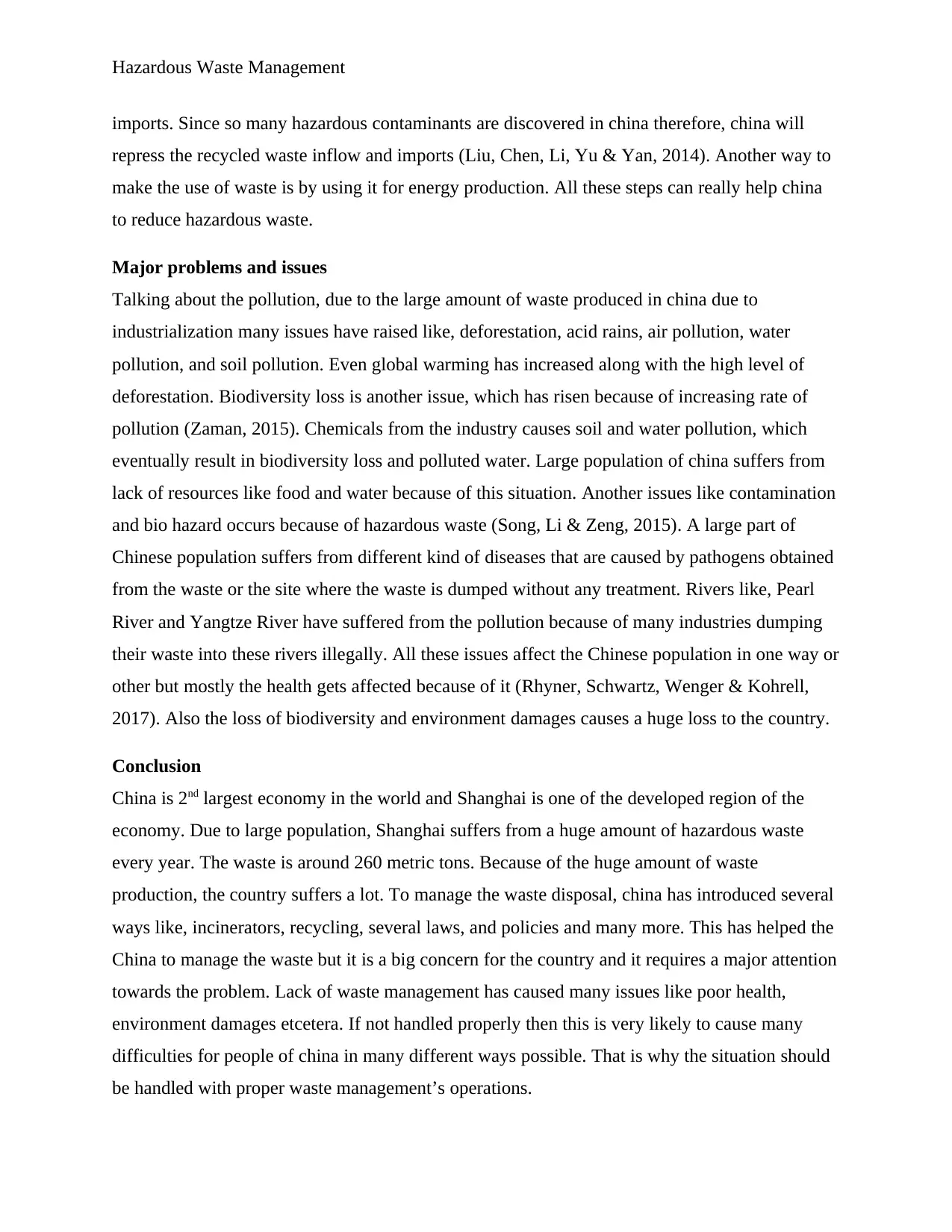
Hazardous Waste Management
imports. Since so many hazardous contaminants are discovered in china therefore, china will
repress the recycled waste inflow and imports (Liu, Chen, Li, Yu & Yan, 2014). Another way to
make the use of waste is by using it for energy production. All these steps can really help china
to reduce hazardous waste.
Major problems and issues
Talking about the pollution, due to the large amount of waste produced in china due to
industrialization many issues have raised like, deforestation, acid rains, air pollution, water
pollution, and soil pollution. Even global warming has increased along with the high level of
deforestation. Biodiversity loss is another issue, which has risen because of increasing rate of
pollution (Zaman, 2015). Chemicals from the industry causes soil and water pollution, which
eventually result in biodiversity loss and polluted water. Large population of china suffers from
lack of resources like food and water because of this situation. Another issues like contamination
and bio hazard occurs because of hazardous waste (Song, Li & Zeng, 2015). A large part of
Chinese population suffers from different kind of diseases that are caused by pathogens obtained
from the waste or the site where the waste is dumped without any treatment. Rivers like, Pearl
River and Yangtze River have suffered from the pollution because of many industries dumping
their waste into these rivers illegally. All these issues affect the Chinese population in one way or
other but mostly the health gets affected because of it (Rhyner, Schwartz, Wenger & Kohrell,
2017). Also the loss of biodiversity and environment damages causes a huge loss to the country.
Conclusion
China is 2nd largest economy in the world and Shanghai is one of the developed region of the
economy. Due to large population, Shanghai suffers from a huge amount of hazardous waste
every year. The waste is around 260 metric tons. Because of the huge amount of waste
production, the country suffers a lot. To manage the waste disposal, china has introduced several
ways like, incinerators, recycling, several laws, and policies and many more. This has helped the
China to manage the waste but it is a big concern for the country and it requires a major attention
towards the problem. Lack of waste management has caused many issues like poor health,
environment damages etcetera. If not handled properly then this is very likely to cause many
difficulties for people of china in many different ways possible. That is why the situation should
be handled with proper waste management’s operations.
imports. Since so many hazardous contaminants are discovered in china therefore, china will
repress the recycled waste inflow and imports (Liu, Chen, Li, Yu & Yan, 2014). Another way to
make the use of waste is by using it for energy production. All these steps can really help china
to reduce hazardous waste.
Major problems and issues
Talking about the pollution, due to the large amount of waste produced in china due to
industrialization many issues have raised like, deforestation, acid rains, air pollution, water
pollution, and soil pollution. Even global warming has increased along with the high level of
deforestation. Biodiversity loss is another issue, which has risen because of increasing rate of
pollution (Zaman, 2015). Chemicals from the industry causes soil and water pollution, which
eventually result in biodiversity loss and polluted water. Large population of china suffers from
lack of resources like food and water because of this situation. Another issues like contamination
and bio hazard occurs because of hazardous waste (Song, Li & Zeng, 2015). A large part of
Chinese population suffers from different kind of diseases that are caused by pathogens obtained
from the waste or the site where the waste is dumped without any treatment. Rivers like, Pearl
River and Yangtze River have suffered from the pollution because of many industries dumping
their waste into these rivers illegally. All these issues affect the Chinese population in one way or
other but mostly the health gets affected because of it (Rhyner, Schwartz, Wenger & Kohrell,
2017). Also the loss of biodiversity and environment damages causes a huge loss to the country.
Conclusion
China is 2nd largest economy in the world and Shanghai is one of the developed region of the
economy. Due to large population, Shanghai suffers from a huge amount of hazardous waste
every year. The waste is around 260 metric tons. Because of the huge amount of waste
production, the country suffers a lot. To manage the waste disposal, china has introduced several
ways like, incinerators, recycling, several laws, and policies and many more. This has helped the
China to manage the waste but it is a big concern for the country and it requires a major attention
towards the problem. Lack of waste management has caused many issues like poor health,
environment damages etcetera. If not handled properly then this is very likely to cause many
difficulties for people of china in many different ways possible. That is why the situation should
be handled with proper waste management’s operations.
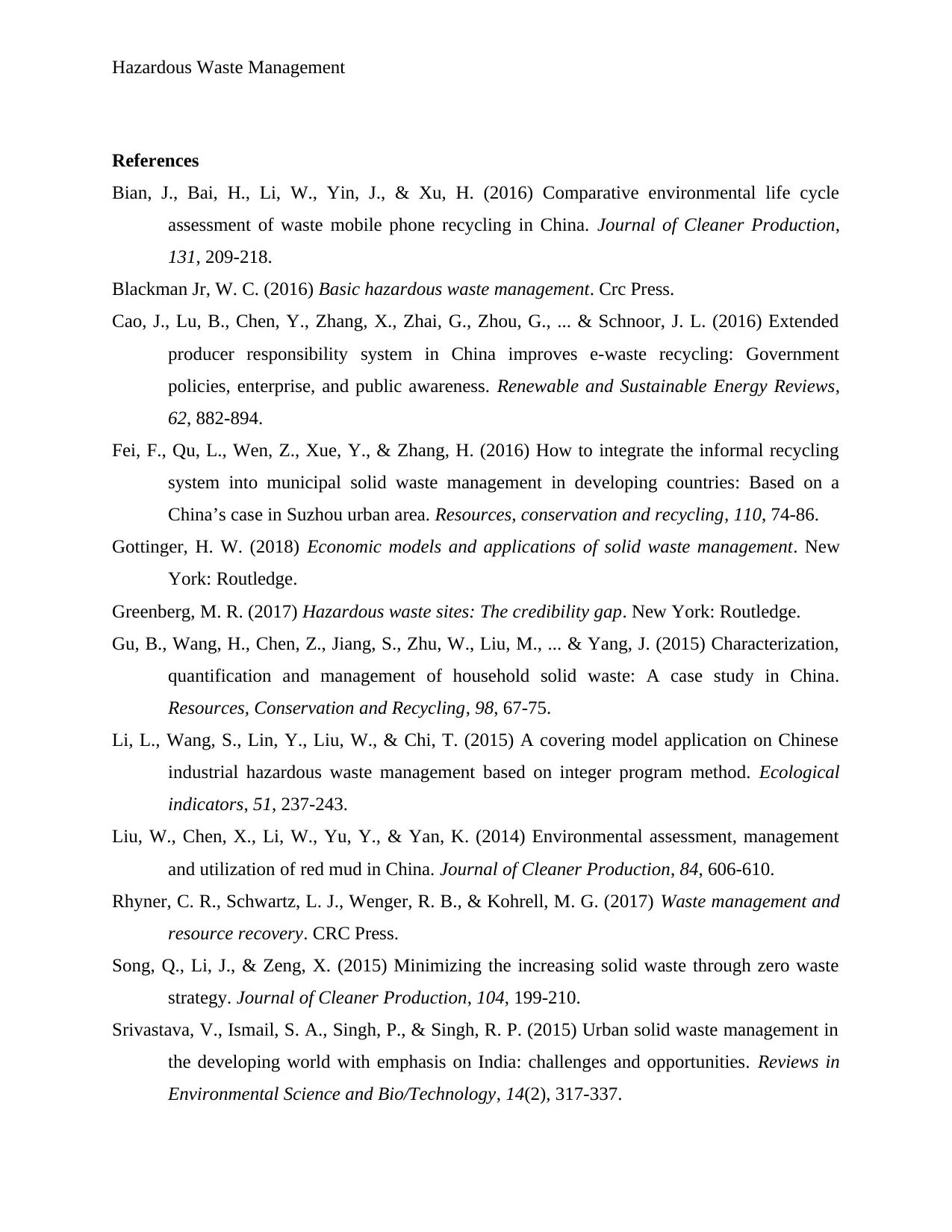
Hazardous Waste Management
References
Bian, J., Bai, H., Li, W., Yin, J., & Xu, H. (2016) Comparative environmental life cycle
assessment of waste mobile phone recycling in China. Journal of Cleaner Production,
131, 209-218.
Blackman Jr, W. C. (2016) Basic hazardous waste management. Crc Press.
Cao, J., Lu, B., Chen, Y., Zhang, X., Zhai, G., Zhou, G., ... & Schnoor, J. L. (2016) Extended
producer responsibility system in China improves e-waste recycling: Government
policies, enterprise, and public awareness. Renewable and Sustainable Energy Reviews,
62, 882-894.
Fei, F., Qu, L., Wen, Z., Xue, Y., & Zhang, H. (2016) How to integrate the informal recycling
system into municipal solid waste management in developing countries: Based on a
China’s case in Suzhou urban area. Resources, conservation and recycling, 110, 74-86.
Gottinger, H. W. (2018) Economic models and applications of solid waste management. New
York: Routledge.
Greenberg, M. R. (2017) Hazardous waste sites: The credibility gap. New York: Routledge.
Gu, B., Wang, H., Chen, Z., Jiang, S., Zhu, W., Liu, M., ... & Yang, J. (2015) Characterization,
quantification and management of household solid waste: A case study in China.
Resources, Conservation and Recycling, 98, 67-75.
Li, L., Wang, S., Lin, Y., Liu, W., & Chi, T. (2015) A covering model application on Chinese
industrial hazardous waste management based on integer program method. Ecological
indicators, 51, 237-243.
Liu, W., Chen, X., Li, W., Yu, Y., & Yan, K. (2014) Environmental assessment, management
and utilization of red mud in China. Journal of Cleaner Production, 84, 606-610.
Rhyner, C. R., Schwartz, L. J., Wenger, R. B., & Kohrell, M. G. (2017) Waste management and
resource recovery. CRC Press.
Song, Q., Li, J., & Zeng, X. (2015) Minimizing the increasing solid waste through zero waste
strategy. Journal of Cleaner Production, 104, 199-210.
Srivastava, V., Ismail, S. A., Singh, P., & Singh, R. P. (2015) Urban solid waste management in
the developing world with emphasis on India: challenges and opportunities. Reviews in
Environmental Science and Bio/Technology, 14(2), 317-337.
References
Bian, J., Bai, H., Li, W., Yin, J., & Xu, H. (2016) Comparative environmental life cycle
assessment of waste mobile phone recycling in China. Journal of Cleaner Production,
131, 209-218.
Blackman Jr, W. C. (2016) Basic hazardous waste management. Crc Press.
Cao, J., Lu, B., Chen, Y., Zhang, X., Zhai, G., Zhou, G., ... & Schnoor, J. L. (2016) Extended
producer responsibility system in China improves e-waste recycling: Government
policies, enterprise, and public awareness. Renewable and Sustainable Energy Reviews,
62, 882-894.
Fei, F., Qu, L., Wen, Z., Xue, Y., & Zhang, H. (2016) How to integrate the informal recycling
system into municipal solid waste management in developing countries: Based on a
China’s case in Suzhou urban area. Resources, conservation and recycling, 110, 74-86.
Gottinger, H. W. (2018) Economic models and applications of solid waste management. New
York: Routledge.
Greenberg, M. R. (2017) Hazardous waste sites: The credibility gap. New York: Routledge.
Gu, B., Wang, H., Chen, Z., Jiang, S., Zhu, W., Liu, M., ... & Yang, J. (2015) Characterization,
quantification and management of household solid waste: A case study in China.
Resources, Conservation and Recycling, 98, 67-75.
Li, L., Wang, S., Lin, Y., Liu, W., & Chi, T. (2015) A covering model application on Chinese
industrial hazardous waste management based on integer program method. Ecological
indicators, 51, 237-243.
Liu, W., Chen, X., Li, W., Yu, Y., & Yan, K. (2014) Environmental assessment, management
and utilization of red mud in China. Journal of Cleaner Production, 84, 606-610.
Rhyner, C. R., Schwartz, L. J., Wenger, R. B., & Kohrell, M. G. (2017) Waste management and
resource recovery. CRC Press.
Song, Q., Li, J., & Zeng, X. (2015) Minimizing the increasing solid waste through zero waste
strategy. Journal of Cleaner Production, 104, 199-210.
Srivastava, V., Ismail, S. A., Singh, P., & Singh, R. P. (2015) Urban solid waste management in
the developing world with emphasis on India: challenges and opportunities. Reviews in
Environmental Science and Bio/Technology, 14(2), 317-337.
⊘ This is a preview!⊘
Do you want full access?
Subscribe today to unlock all pages.

Trusted by 1+ million students worldwide
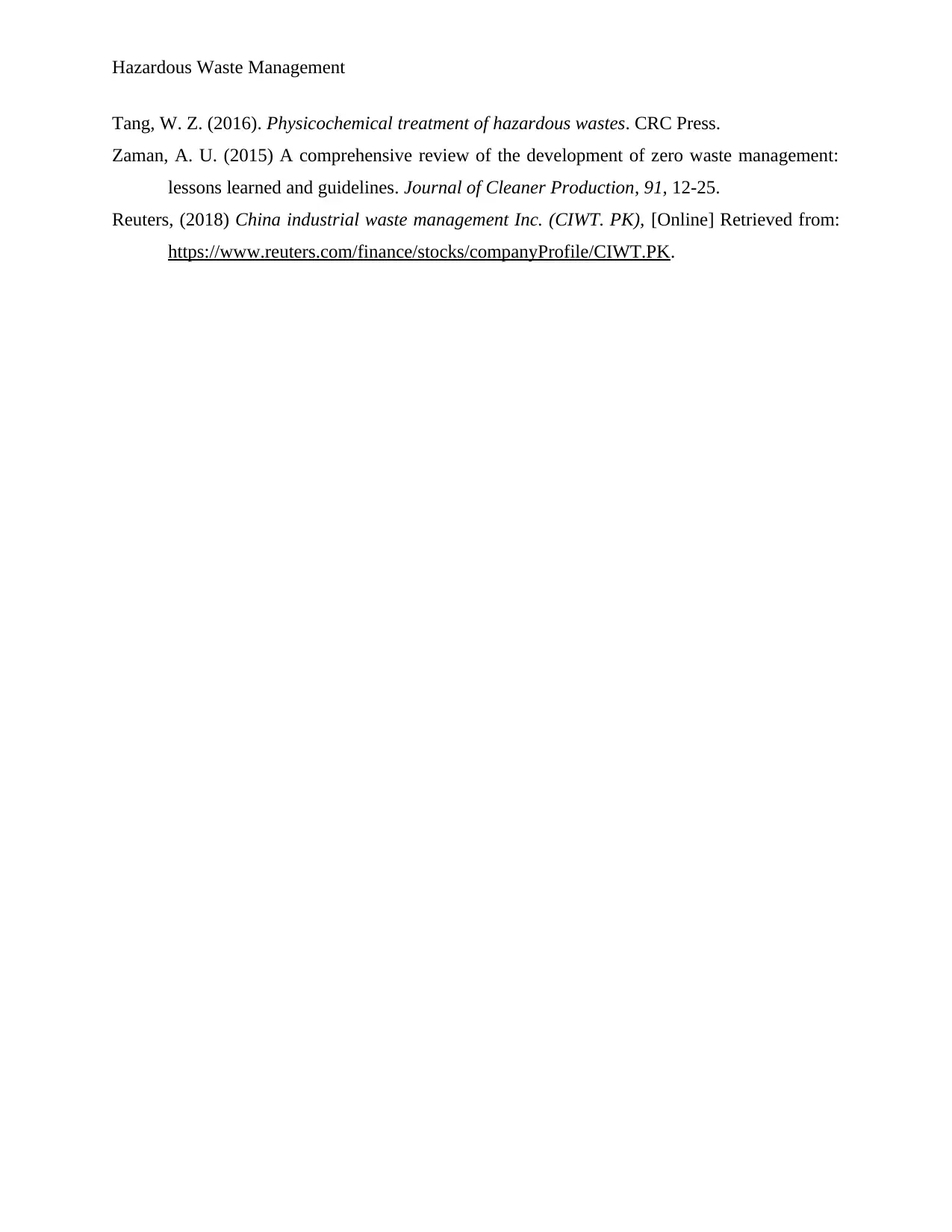
Hazardous Waste Management
Tang, W. Z. (2016). Physicochemical treatment of hazardous wastes. CRC Press.
Zaman, A. U. (2015) A comprehensive review of the development of zero waste management:
lessons learned and guidelines. Journal of Cleaner Production, 91, 12-25.
Reuters, (2018) China industrial waste management Inc. (CIWT. PK), [Online] Retrieved from:
https://www.reuters.com/finance/stocks/companyProfile/CIWT.PK.
Tang, W. Z. (2016). Physicochemical treatment of hazardous wastes. CRC Press.
Zaman, A. U. (2015) A comprehensive review of the development of zero waste management:
lessons learned and guidelines. Journal of Cleaner Production, 91, 12-25.
Reuters, (2018) China industrial waste management Inc. (CIWT. PK), [Online] Retrieved from:
https://www.reuters.com/finance/stocks/companyProfile/CIWT.PK.
1 out of 10
Related Documents
Your All-in-One AI-Powered Toolkit for Academic Success.
+13062052269
info@desklib.com
Available 24*7 on WhatsApp / Email
![[object Object]](/_next/static/media/star-bottom.7253800d.svg)
Unlock your academic potential
Copyright © 2020–2025 A2Z Services. All Rights Reserved. Developed and managed by ZUCOL.





